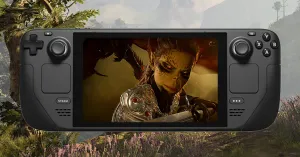Here are our updated best settings for Baldur's Gate 3 on Steam Deck, Larian Studio's latest masterpiece.
Nearly half a year has passed since the highly successful launch of Baldur's Gate 3 on PC. During this time, Larian has made numerous improvements through countless updates. Meanwhile, Valve released the Steam Deck OLED as a mid-generation surprise. As such, now is a good time to revisit the Game of the Year 2023, Baldur's Gate 3, to see how it fares on the Steam Deck nowadays and to update the settings accordingly.
HDR is a good thing... r-... right?!
There's some likelihood that you may be using an OLED Steam Deck by now, which brings us to an important point right off the bat: enabling High Dynamic Range (HDR) in Baldur's Gate 3 significantly impacts performance.
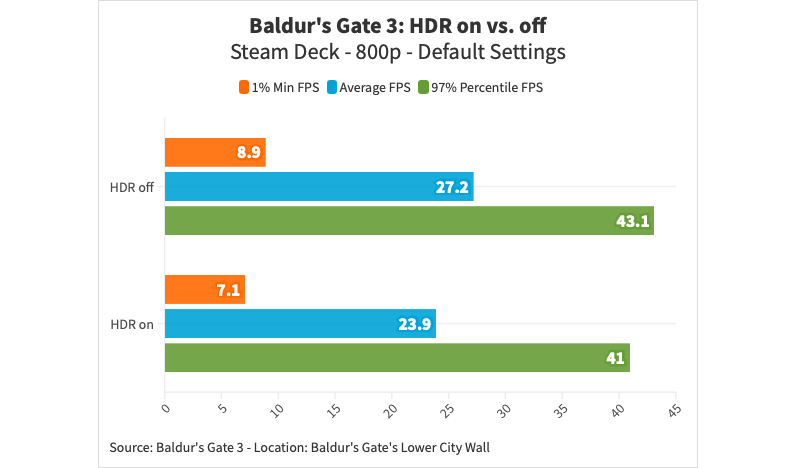
It's somewhat surprising that Larian didn't thoroughly reconsider this feature's compatibility with the Steam Deck, especially given its Deck-verified status. Contrary to expectations, they didn't just overlook this issue; they went a step further. Baldur's Gate 3 automatically enables HDR on OLED models without any official in-game or launcher-side options to disable it.
However, there's good news: I directly contacted Valve developer Joshua Ashton about this issue, and he provided me with a launch command that can forcefully disable HDR for games on an OLED Steam Deck.
DXVK_HDR=0 %command%
To apply this tweak, just head into the game's Steam library settings (the cogwheel on the right) and insert the line into the 'Launch Options' field. That's it - BG3 will now resort to Standard Dynamic Range (SDR).
Still great... till Act III
After the good news, comes a sad one: Larian still didn't manage to fix the subpar performance of the game's third act. The city of Baldur's Gate proved to be a challenge for anyone seeking solid frame pacing, and six months later, this unfortunately didn't change at all.
Outside of the third act, it's actually possible to aim for a 30FPS lock thanks to AMD FSR 2.2. Here, the general baseline of the game improved and runs a bit better across the board — especially on an OLED Steam Deck. Though, no matter what I tried, getting a somewhat stable frame rate beyond 24FPS in the game's biggest city is impossible. I still managed to achieve ever so small frame pacing improvements by disabling Dynamic Crowds, as well as lowering the Occlusion Audio Quality.
Keeping all of that in mind, the general recommendation to stick to 24FPS — at least once you're in act III — still persists. Thankfully, this isn't as bad as it sounds, especially for OLED Steam Deck users: That low FPS lock fares fairly well due to the increased pixel response time of that panel, combined with a 72Hz refresh rate.
Updated Settings for Baldur's Gate 3 on Steam Deck
Below you'll find the updated settings for Baldur's Gate 3 on Steam Deck. Major changes are marked in bold, including my additional findings — such as Temporal Anti-Aliasing (TAA) being disabled because it results in blurry textures when combined with FSR 2.2.
| Video Settings (in-game) | |
|---|---|
| Display Mode | Fullscreen |
| VSync | Off |
| Frame Rate Cap | Off |
| Model Quality | Low |
| Detail Distance | Medium |
| Instance Distance | Medium |
| Texture Quality | Ultra |
| Texture Filtering | Anisotropic x16 |
| Animation Level of Detail | High |
| Slow HDD Mode | Off |
| Dynamic Crowds | Off |
| Shadow Quality | Medium |
| Cloud Quality | Medium |
| Fog Quality | Medium |
| AMD FSR 2.2 | Quality |
| FidelityFX Sharpening | On |
| Sharpness | 50% |
| Anti-Aliasing | None |
| Ambient Occlusion | On |
| Depth of Field | Gaussian |
| Depth of Field Quality | Quarter Denoise |
| Godrays | On |
| Bloom | On |
| Subsurface Scattering | On |
| Audio Settings (in-game) | |
| Occlusion Quality | Low |
| Quick Action Menu | |
|---|---|
| Use per-game profile | Enabled |
| Framerate Limit | 24FPS or 30FPS |
| Allow Tearing | Disabled |
Let's hope Larian Studios keeps improving Baldur's Gate 3 through new patches so that one day, we might be able to enjoy all three acts of this hit game at 30 FPS. Meanwhile, a good hack might be to disable the frame rate counter altogether — crazy, I know.
Original Story:
Baldur's Gate 3 Review: Performance & Best Settings for Steam Deck
I had planned for a quiet evening, but the universe had other ideas: While waiting for a server in a local pub, I was suddenly caught in a heated fight. Looking for a way out, I noticed a big salami on a neighbouring table. I picked it up in a moment of spontaneity, swinging it in the air. My opponent erupted in laughter, diffusing the tension. It's funny how the most random things can save the day – especially in Baldur’s Gate 3.
I wasn't prepared for how captivating the new RPG by Larian Studios is. Not only are such games without an extensive list of microtransactions and always-online features a rarity nowadays, but the new title — set in the Dungeons & Dragons universe — arrives incredibly polished and brings an extraordinary amount of content to the table.
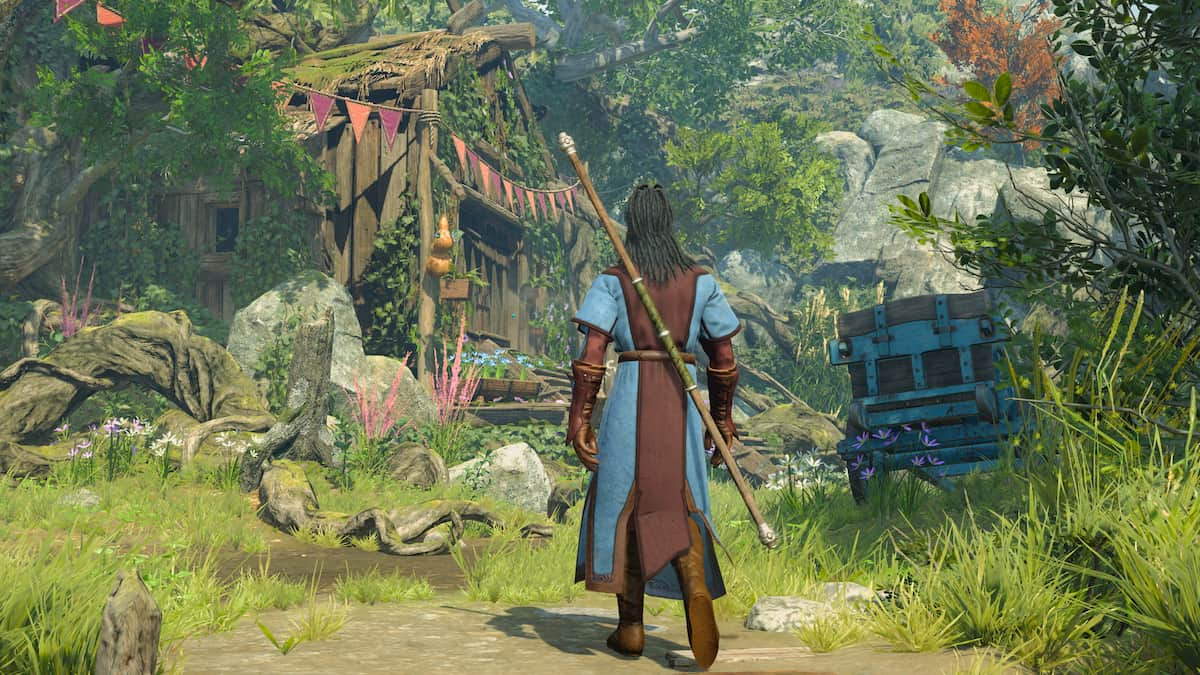
Naturally, you might wonder how an epic adventure of this scale would fare on the Steam Deck. Look no further, kind traveller. We have the answers to your questions, even if they may be controversial. Buckle up and get your dice ready!
Casting "Plug and Play" - the game out of the box
When you first start the game on the Steam Deck, Baldur's Gate 3 skips its Larian-launcher heading straight into the game. On PC, you'd be able to not only log in to your Larian account to enable cross-progress but also choose between the DirectX 11 and Vulkan versions of the game. While DX11 is meant for older hardware (and Nvidia users), the AMD-based Steam Deck fares better on Vulkan, so the game picks for you.
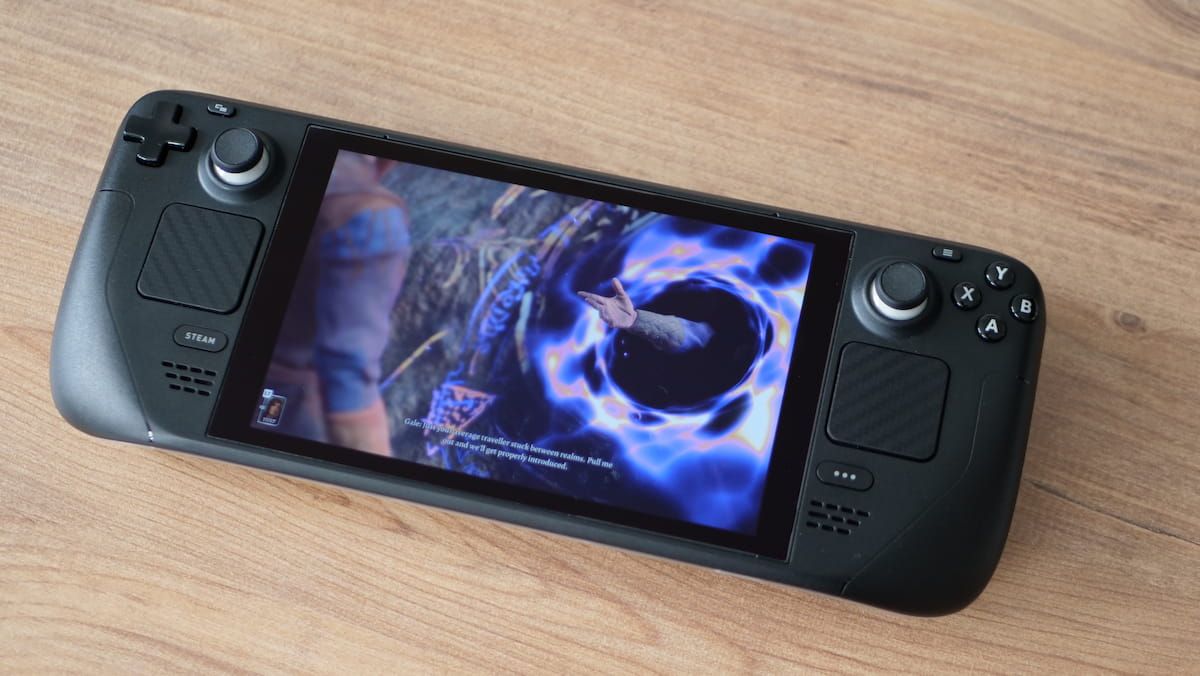
The stock settings resort to the medium graphics preset at 1280x800, while leveraging AMD’s FidelityFX Super Resolution (FSR) as an upscaling technique. Unfortunately, the latest Dungeons & Dragons epic launches with AMD's old static FSR 1, which is prone to producing fuzzy results that look anything but good. Larian plans to add FSR 2.2, a temporal upscaler, in a coming update.
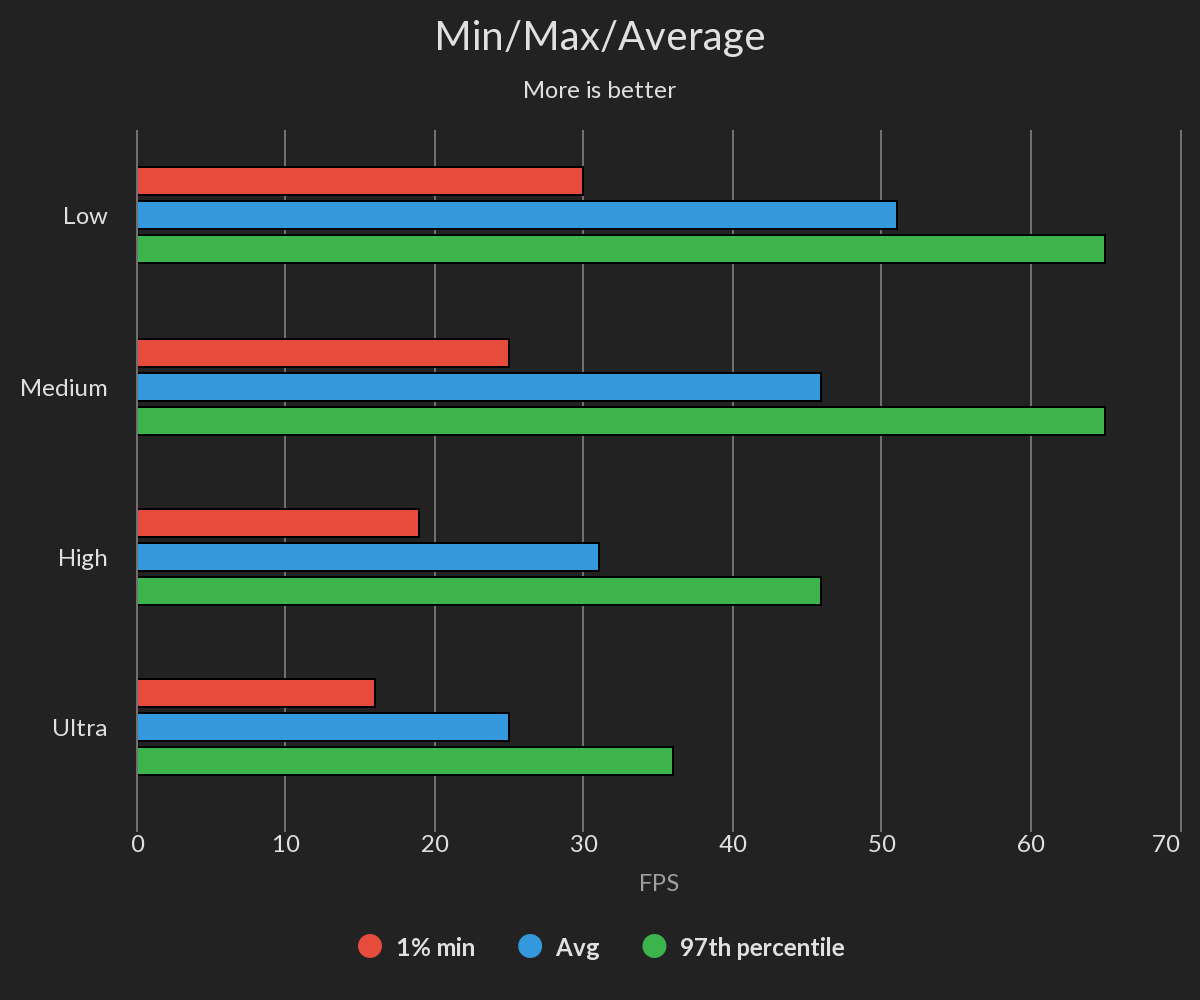
While the medium settings give us suitable visuals, you will see blurry textures, hideous ghosting, and an unstable experience on the performance front. Although the game can reach some impressive peaks of up to 55 FPS —most of the time, the Deck wobbles around at an inconsistent frame rate range between 28 to 40 FPS. You might assume that an FPS cap at 40 or even 30 could be the solution here, but in reality, you'll have to deal with regular dips into the twenties.
This is especially true in moments with more action on screen, such as during extensive combat scenarios or conversations with multiple characters, the frame pacing bids farewell—and we can rarely do anything about it. Or could we?
Beware the Frame-Pacing Dragon!
To have a pleasant experience on performance-limited handhelds such as the Steam Deck you should always focus on the frame pacing first. With proper pacing, where the frame rate is consistently held without significant variation, every game can feel 'smooth' on Deck. Sure, the net amount of frames per second also alters the input delay you’d perceive on your mobile gaming endeavours - but aside from fighting games and first-person shooters, where pinpoint reactions and timing are critical, you rarely need more than 30 FPS for a good gaming experience.
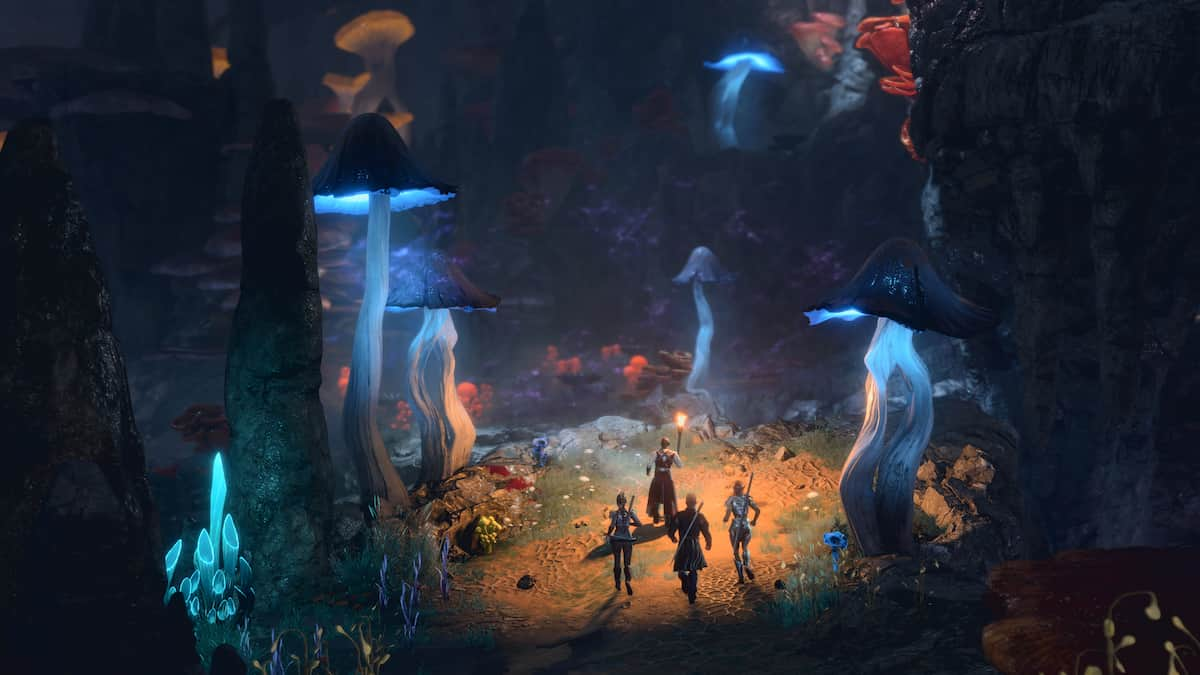
Holding a rock-solid 30 FPS in Baldur’s Gate 3 on the Steam Deck turned out to be an adventure on its own. Too often, we've seen rendering spikes pushing the hardware's limits, resulting in a jarring pacing and regular stutters during traversal and combat. Although still not the preferred solution, FSR1 comes in handy to clear up some additional headroom here and make the game behave accordingly. But this comes at a painful cost this piece of art simply doesn’t deserve - the loss of overall fidelity and texture sharpness.
Still - when one accepts this blurry fate and fully embraces the currently available F(uzzy)SR implementation, resorting to the lowest settings at 800p with textures at medium often results in 45 to 60 frames per second. You probably won't be able to make out many of the neat details Larian’s incredibly talented artists created over the last few years, but you get what you ask for.
Thankfully, extensive testing resulted in finding something that I'd consider a real fix to the game's current state. But, as always, everything comes with a price.
A costly Endeavor and its outcome
Thanks to the Steam Deck's display capabilities to use a 40Hz refresh rate, the community promptly settled for 40FPS at 40Hz, for great frame pacing and vastly improved fluidity over 30FPS. In an ideal world, this would require good rendering headroom to prevent significant performance drops.
However, even with FSR1 incorporated and all of its presets compared against each other, there’s no way to circumvent regular dips below 30FPS. Regardless of which FSR setting you try, the result will always be a blurry mess that doesn't do justice to the visual brilliance of the game.
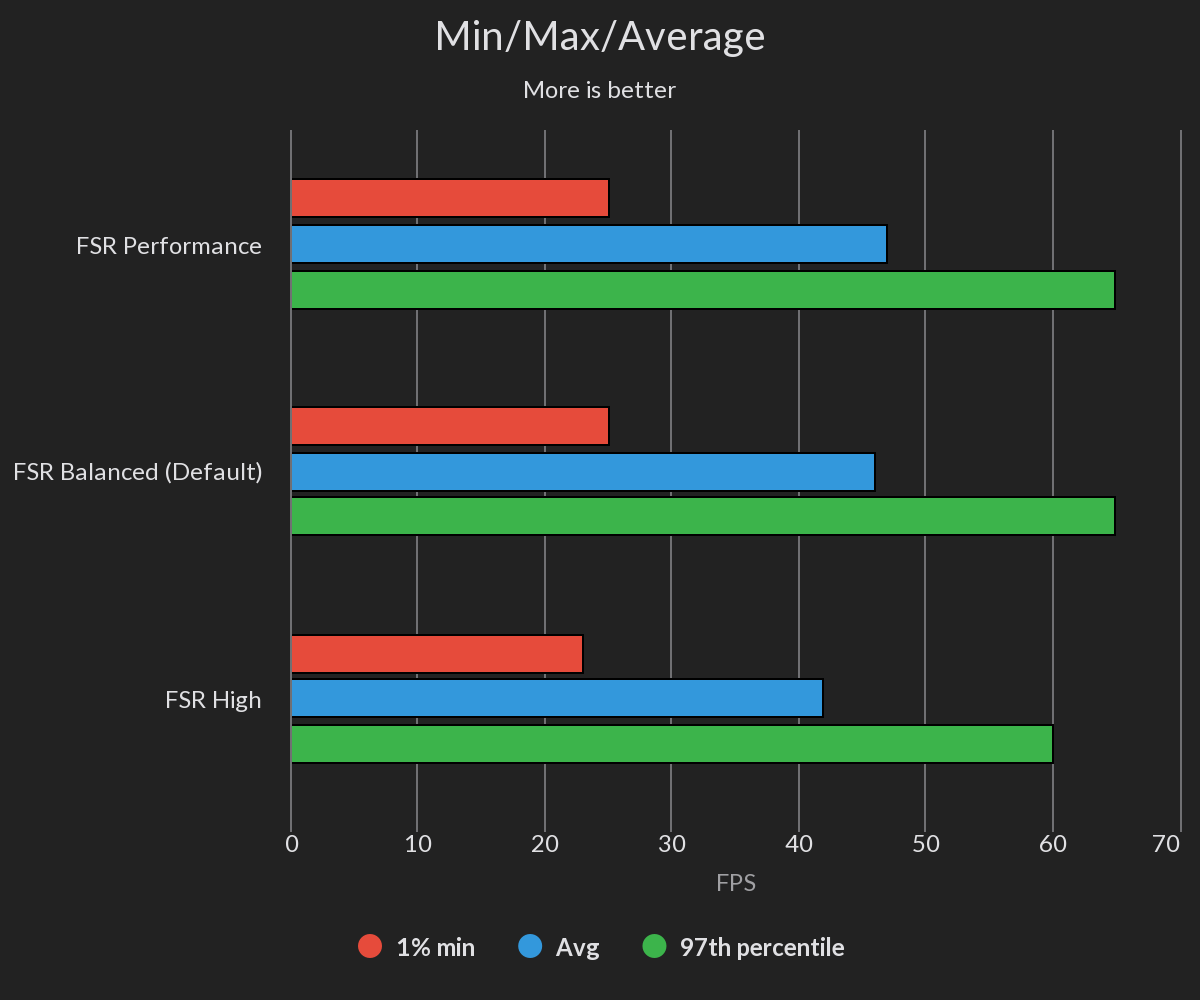
A game like Baldur’s Gate and its epic experience rise and fall with its - for the lack of a better word - escapism. A rock-solid frame pacing is one of the foundations to fully immerse yourself in all the adventures the Forgotten Realms offer.
Therefore, I've experimented with a different approach: Fully embracing the baseline to improve visuals as far as possible. And after countless benchmarks and hours upon hours, I've realised that we need to pay a huge toll for a proper result. At least until Larian Studios releases an update to add FSR 2.2.
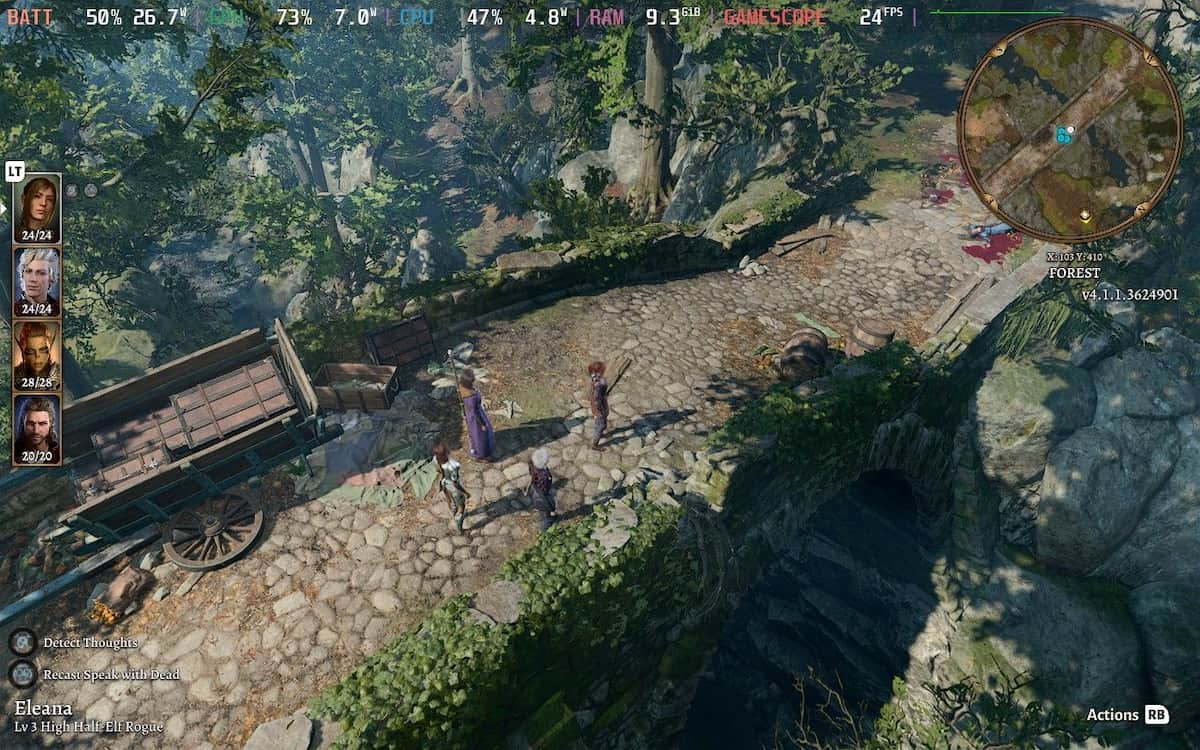
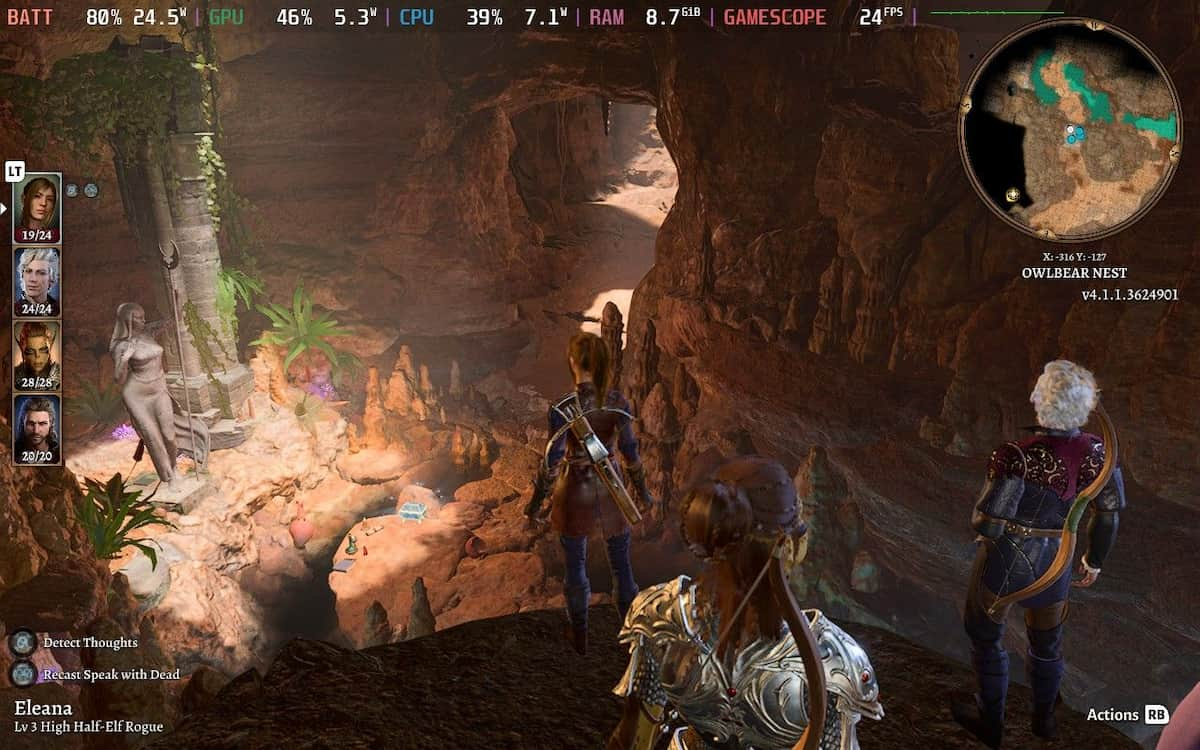
The following settings will give you a consistent frame rate of 24 FPS. You've read that right. Not 30, not 40, but 24 FPS. I promise this will make sense in a moment.
| Video Settings (in-game) | |
|---|---|
| Display Mode | Fullscreen |
| VSync | Off |
| Frame Rate Cap | Off |
| Model Quality | Low |
| Detail Distance | Medium |
| Instance Distance | Medium |
| Texture Quality | Ultra |
| Texture Filtering | Anisotropic x16 |
| Animation Level of Detail | High |
| Slow HDD Mode | Off |
| Dynamic Crowds | On |
| Shadow Quality | Medium |
| Cloud Quality | Medium |
| Fog Quality | Medium |
| AMD FSR 1.0 | Off |
| FidelityFX Sharpening | On |
| Sharpness | 50% |
| Anti-Aliasing | TAA |
| Ambient Occlusion | On |
| Depth of Field | Circular |
| Depth of Field Quality | Quarter |
| Godrays | On |
| Bloom | On |
| Subsurface Scattering | On |
| Audio Settings (in-game) | |
| Occlusion Quality | Medium |
| Quick Action Menu | |
|---|---|
| Use per-game profile | Enabled |
| Framerate Limit | 24FPS |
| Refresh Rate | 48Hz |
| Allow Tearing | Enabled |
Before you dive into Baldur’s Gate 3 and give these settings a go, let’s talk about the elephant in the room: Twenty-four frames per second. Let me tell you that I would have called you crazy if you told me I’d ever accept anything lower than "console-esque, cinematic" 30 FPS. I'm an advocate for all things Golden 40, after all.
To cut to the chase, there's a reason I've settled for 24FPS at 48Hz: Big-budget movies to this day run at a frame rate of 24FPS. After all, they're providing non-interactive content, but this is still something your brain is used to. It’s a worthy trade-off compared to the need for FSR; otherwise, Settling for that FPS cap adds enough rendering headroom to enable us to ditch FSR altogether and use FidelityFX Sharpening, which massively boosts overall clarity at 800p.
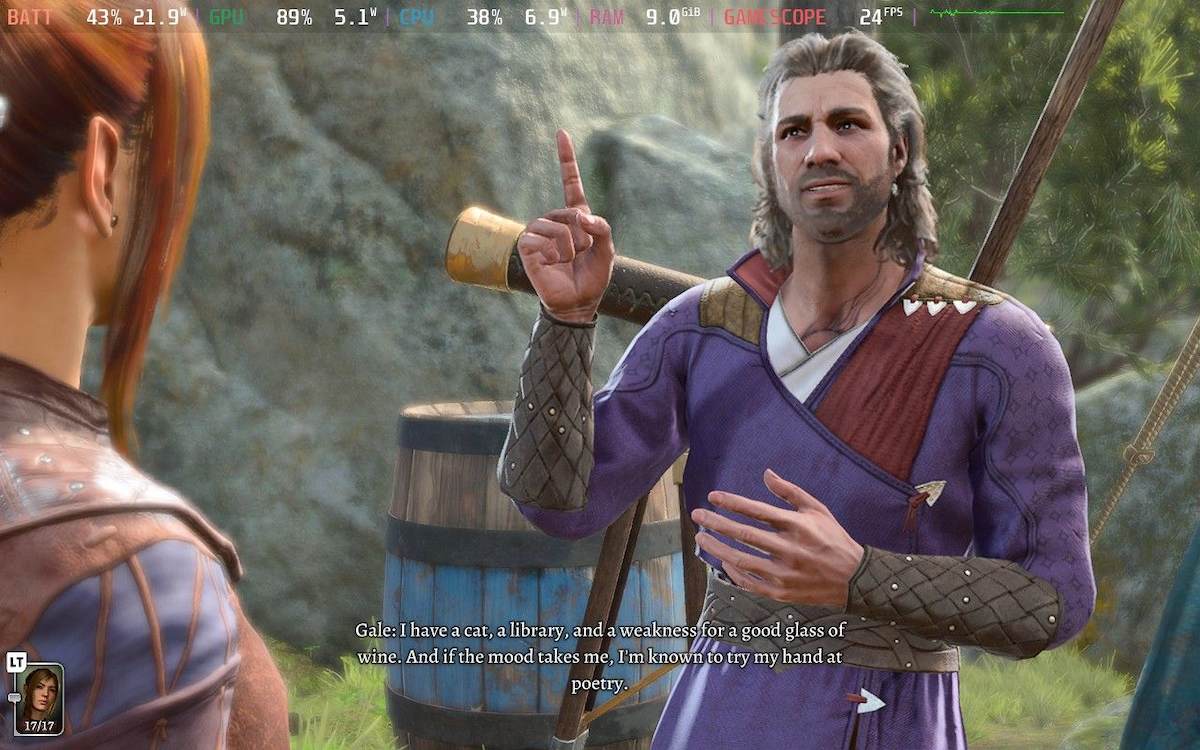
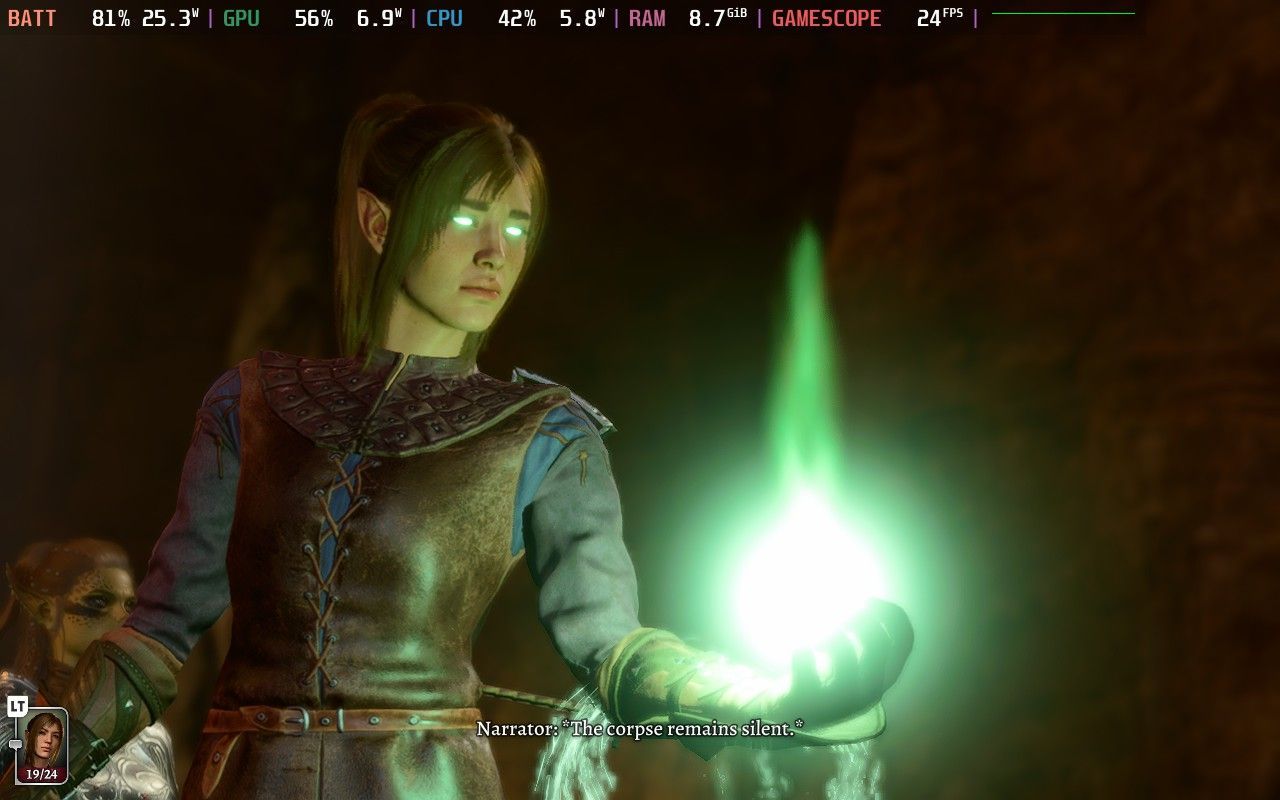
To some degree, Baldur’s Gate 3 has the advantage of being more of a narrative experience that’s more comparable to movies than many games where quick reactions matter, like, say, Diablo IV. As such, the Baldur’s Gate 3 experience lends itself well to this lower FPS, particularly when combined with on-point frame pacing.
I’ve spent nearly six hours in the game on Deck, with the frame rate capped at 24FPS, and I can attest not having to deal with stuttering is vastly superior to any performance improvement. On top of that, at 48Hz, you won’t see the display suffer from PWM flicker, which some people can’t bear when trying to play on the Golden 40’s 40Hz refresh rate.
Epilogue: Meditating on Gains and Losses
As solid as the experience will be now, all of this still comes at a price, aside from the challenge of the first 30 minutes until your brain adjusts to the result: The Deck's battery will only last up to 1.5 hours. The table may turn once FSR2.2 arrives, but until then, you’ll need to have a power socket nearby or get creative to add a lower TDP limit.
But all the effort is worth it and will pay off, as Larian Studios has truly crafted an astonishing masterpiece. Baldur’s Gate 3 will easily take a seat among the most praised games of the year, if not all time. Being able to explore the vast world of the Forgotten Realms on a handheld like the Steam Deck while getting lost in a ridiculous amount of content, conversations, and decisions is something to behold.
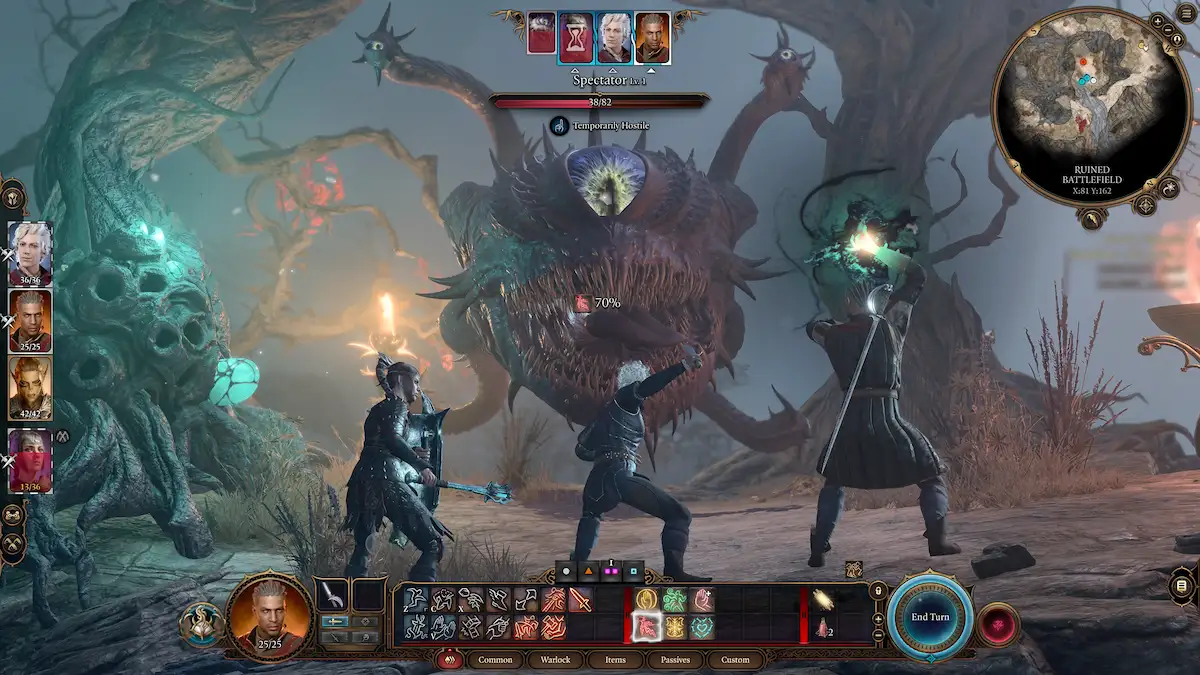
Given its massive success and popularity, I can only imagine how much the game and its performance will inevitably improve over time. We will, of course, update this guide accordingly.
As an anecdotal closing thought, it feels surreal how many excellent games have been released throughout the last eight months alone. And there are many more on the horizon — wild times.


